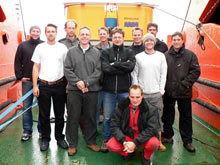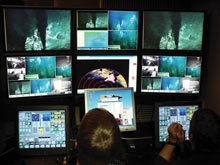View of the front of the remotely operated vehicle (ROV), which consists of propellers, hydraulic pumps and lots of cameras, lights and electronics, as well as two robotic "arms." Click image for larger view and image credit.
An ROV at Brothers Volcano
August 14, 2007
Colin Devey
Chief Scientist
IFM-GEOMAR
Quest 7 ROV Team
Buying a complex underwater vehicle is not like buying, say, a computer. In the case of the computer, you take it home, switch it on, and expect it to work. Not so with a remotely operated vehicle (ROV). Just the ROV alone consists of propellers, hydraulic pumps and lots of cameras, lights and electronics, as well as two arms, all of which need to work at enormous pressures surrounded by seawater. Add to that a winch holding almost 4 miles of cable, and a whole 20-foot van crammed with electronics to control the vehicle. All in all, we're talking about a lot of equipment, which needs to be thoroughly tested before we can use it for science.
That is why we, a team of eight scientists and engineers, co-chartered the research vessel (R/V) Sonne to do these tests. As it turns out, the testing went really well and so we were able to do some science too, but that was an added bonus.
But enough about tests. Let me introduce the team. Take a look at the group photo (below). At the front is Erik Labahn, an engineer with lots of sea-going experience who flew an ROV for the first time on this cruise (and really enjoyed it!). Next row, on the right, is Martin Pieper, a mechanical engineer who plays a key role in maintaining and deploying the ROV. Then there's Andy Foster, a Scotsman and engineer from Schilling Robotics, the California-based company who built the vehicle. Andy is based in Aberdeen, Scotland (you can tell by his accent!), and spends a lot of time flying ROVs among the legs of oil rigs out in the North Sea. Next to him is Thomas Kuhn, a geology PhD and team leader. That's me next to him, and to my right is Karsten Witkiewicz, an electronics engineer who (until he joined us several months ago) worked for Panasonic developing automobile radios! For Karsten, Claus Hinz, and Hannes Hussmann (we'll get to them shortly) this was their first time at sea – a big adventure!
Back row on the right is Arne Meier, our calm and careful winch technician; Claus Hinz, the IT-engineer, is next to him. All the ROV communications run using the standard internet TCP/IP protocol, so for Claus the ROV is his own private underwater Internet! Greg Engemann, next to Claus, is an engineer from Schilling Robotics and head of their vehicle delivery group. Next to him is Hannes Huusmann who is a student of media technology doing a practical semester with the ROV team. Hannes is responsible for the collection and processing of all the video information which we have stored on several terabytes of hard disc space. And the last guy (in the hat) is Robert Surma from German Lloyd's, the insurers, making sure the vehicle is safe to use and giving lots of tips on how to make it easier to handle.
So, what did we do? After about a week spent building the whole system up and testing it on deck, we sent it down to the sea floor on a total of three, seven-hour long dives. During the dives, two pilots are always in the control van, responsible for steering the vehicle and the "grab arms," and also navigating the vehicle and ensuring that it is still functioning properly. The ROV runs on a 4,000 volt power supply: if any water gets into the electronics at that sort of voltage we need to shut them down quickly or we will fry lots of expensive gear, so there are leak detectors throughout the vehicle.
The photo (above) shows Karsten on the left and Martin in front of the pilot displays. On the upper screens you can see the pictures being sent back directly from the ROV, which clearly was hovering in front of a “black smoker” vent at the time. The water which makes the black “smoke” is at 350° C (660º F), hot enough to melt many of the components on the ROV so the pilots have a tough job flying in such regions. They are just the places where we, as scientists, want to take scientific sample — so we have to take the risk!
Sign up for the Ocean Explorer E-mail Update List.



















